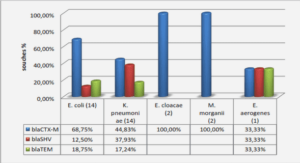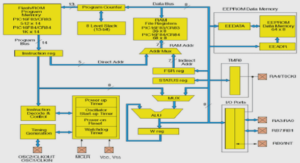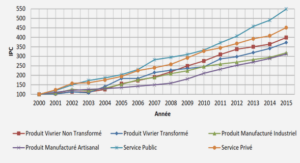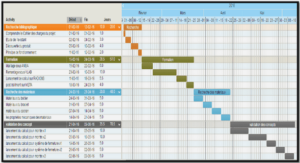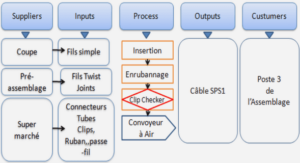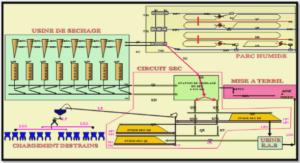Interaction gènes-environnement dans l’asthme
METHODS
Subjects
A well-characterized family sample of asthmatic patients from the founder population of SLS J was used to investigate the association between genes selected based on interaction reported with specific environmental exposure and asthma. Asthma phenotype was described following the American Thoracic Society standards (17): all participants had a respiratory health questionnaire and function tests. Participants were defined as having asthma if (i) they had a reported history of asthma (validated by a physician); or (2) they showed asthma-related symptoms and a positive PC20 at the time of recruitment. Subjects with a PC20 greater than 8 mg/mL; without history of physician-diagnosed asthma, and without symptoms of asthma; and with no positive response on skin prick test were considered unaffected for asthma. Detailed recruitment method is described in the paper by Begin et al 2007 (18). Probands were included in the study if they met two of the three following criteria: (1) a minimum of three clinic visits for acute asthma within one year; (2) two or more asthma related hospital admissions within one year; (3) steroid dependency, defined by either a use of oral corticosteroids for six months, or a year for inhaled corticosteroids. Families were included in the study if phenotypic assessment was available for at least one parent, at least one parent was unaffected, and if all grandparents were French-Canadian descendants. Family members were considered asthmatics if both a selfreported history of asthma and a history of physician diagnosed asthma were recorded, or by clinical evaluation following a methacholine provocation test. Spirometry, methacholine challenge and IgE measurements are detailed in Begin et al 2007 (18). Spirometry was performed to measure the expiratory flow (FEVi) using a Morgan spirometer (Morgan Spiro 232, P.K. Morgan Ltd) following the American Thoracic Society’s recommendations (19). Methacholine challenges (bronchoprovocation) were performed for participants of 12 years and older according to the method described by Juniper et al (20). The PC20 is described as the dose of methacholine that resulted in a 20% fall in FEVi. Serum IgE was measured with enzyme immunofluorometry. The investigators performed all of the measures for each participant (except for bronchoprovocation) at the University of Montreal Community Genomic Medicine Centre in Saguenay, Québec, Canada. All subjects signed the informed consent approved by the local hospital (Centre de santé et de service sociaux de Chicoutimi) ethics committee. A total of 1428 individuals from 254 nuclear families were included the study (Table 7).
Gene Selection and Genotypes
Eight genes were selected from the literature: immune signalling molecules (TGFB1 and TNF), immune response molecule (MPO), genes implicated in free radical metabolism (CAT, EPHX1, GSTP1 and NQO1) and metabolic enzyme (ARG1). The specific genes were selected in the literature using PubMed. Genes had to have one or more polymorphisms (SNPs) associated to asthma in an environment related to air pollution (pollutant related to industries or other pollutant found in the SLSJ region). Key words used were: air pollution, carbon monoxide, ozone, nitrogen oxide, particulate matter, sulfur dioxide and industries.
SNPs were extracted using the PLINK software from the genome-wide association study (GWAS) performed on the SLSJ familial collection in the context of the large-scale,consortium-based genome wide association study of asthma GABRIEL (21). SNPs extracted were located in the selected genes and their 5′ and 3′ untranslated regions (UTR) (which may contain gene expression regulation sites and promoter regions). A total of 90 SNPs were extracted and a total of 72 were kept for analysis (criteria are mentioned in the statistical analysis section): 64 in the total sample, 69 when stratified according to proximity of aluminium industries and 69 when stratified according to pulp and paper industries. All SNPs are described in Table 11 in the supplementary material.
Environment Characteristics and Air Pollution Data
Subjects of the SLSJ sample were recruited from 1998 to 2001. During these years, only outdoor ozone and sulphur dioxide concentrations were measured routinely in four different places in the SLSJ area. Table 8 is a brief summary of the measures for ozone and sulphur dioxide among these four sites between 1997 and 2000. Both of these pollutants are known to pose a risk to human health and thus ambient air quality standards are in place provincially, federally and also in other countries (22, 23). Air pollutant measures are in part per billion (ppb) and are assessed during a defined period of time (8 hours or 24 hours for longer periods and 1 h for peaks). For example, standards set by the Ministère du Développement durable, de l’Environnement et des Parcs, indicate that the acceptable limits are a maximum value of ozone of 65 ppb for 8 hours and/or 80 ppb for 1 h. The maximum acceptable limits for sulphur dioxide (SO2) are set at 20 ppb for an annual average, 110 ppb for a 24 h average and 500 ppb for 1 h. The levels observed in U.S. cities exceed the standards: the average range of ozone is 0 to 125 ppb for 8 h and the average for SO2 is 0.5 to 50 ppb for 24 h. Also peaks of 200 ppb for 1 h of ozone and 150 ppb for 1 h of SO2 are typically observed in U.S. cities that are not located in areas where there are direct emission sources (24).
|
Table des matières
RÉSUMÉ
AVANT-PROPOS
REMERCIEMENTS
TABLE DES MATIÈRES
LISTE DES TABLEAUX
LISTE DES FIGURES
INTRODUCTION
CHAPITRE 1
1.1 L’asthme
1.1.1 Facteurs de risque de l’asthme
1.1.2 Physiopathologie de l’asthme
1.1.2.1 Hyperréactivité bronchique
1.1.2.2 Inflammation des voies respiratoires
1.1.2.3 Remodelage des voies respiratoires
1.1.2.4 La balance Thl/Th2 dans l’asthme
1.2. Interaction gènes-environnement dans l’asthme
1.2.1 Interaction entre les gènes associés à l’asthme et l’exposition au tabac
1.2.2 Interaction entre les gènes associés à l’asthme et l’exposition aux polluants de l’air
1.2.3 Interaction entre les gènes associés à l’asthme et l’exposition aux endotoxines
1.2.4 Interaction entre les gènes associés à l’asthme et l’exposition lié au lieu de travail
1.3. Sélection des gènes dans la littérature
1.4. Hypothèses et objectifs de l’étude
CHAPITRE 2 : Étude d’association entre l’asthme et les gènes associés à ce phénotype et à la pollution de l’air, dans un environnement rural caractérisé par différentes industries
2.1. Résumé
2.2. Abstract
2.3. Introduction
2.4. Methods
2.4.1 Subjects
2.4.2 Gene selection and genotype
2.4.3 Environment characteristics and air pollution data
2.4.4 Statistical analysis
2.5. Results
2.6. Discussion
2.7. Conclusion
2.8. Acknowledgment
2.9. References
CHAPITRE 3 : Discussion
3.1. La collection familiale asthmatique du Saguenay-Lac-Saint-Jean
3.2. Description de l’environnement du Saguenay-Lac-Saint-Jean
3.3. Analyse par gène candidat
3.4. Perspectives pour les futures études d’interaction gènes-environnement
3.4.1. Biomarqueurs de l’exposition à certains environnements
3.4.2. Interaction entre les données épigénétiques et environnementales
3.4.3. Interaction entre les gènes et plusieurs environnements
3.4.4. Outils bio-informatiques pour étudier les interactions gènes-environnement
CONCLUSION
RÉFÉRENCES
![]() Télécharger le rapport complet
Télécharger le rapport complet

